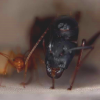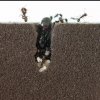H'llo,
This is where I put all my experiments on ants to be more exact Myrmica. I love Myrmica mainly because of how they stand out with their weird behaviour among other ants. I haven't seen a lot of Myrmica species and there are a lot of species out there so none of these these experiments should be taken too seriously or be used to apply to all Myrmica. I'm only including the local Myrmica here. Not too mention BC has a problem with M.rubra and M.specoides both of which are invasive.
(not included Richmond which is good and bad haha)
List of Myrmica spp.
Myrmica sp.1
Nesting habits
Location of colonies: In wood,sometimes under stones and soil.
Nest description: Network of tunnels going through dirt under rocks and in wood. small chambers tunnels are found near the surface but may extend deep into the ground.
Habita/conditions: Anywhere that provides shelter from sunlight and decent amount of vegetation.
Length
Workers: around 4.5 mm
Queens: 6 mm
Males:6 mm or 6.5mm
Characteristics:
workers: red all over some are darker than others, they have a dark red gaster.
They have hair on their gasters and small spines. They are very very very slightly polymorphic
Queens: deep red colour they have dark red coloured heads and the front half of their wings are darkened. They have tiny hairs on their gaster and small spines. (larger than worker spines)
Males: all black,wings slightly darkened at front and orange tip gaster.
Behaviour
Nuptial flights: during late July and August
Activity: All day most active during evening and night.
Myrmica sp.2 (I haven't really study this species and might not have the time to)
Location of colonies:
Nest description:
Habita/conditions:
Length
Workers:
Queens:
Males:
Characteristics:
workers:
Queens:
Males:
Nuptial flights:
Activity:
Colonies I own:
Myrmica sp.1 2 queens a few workers (12 - 18) and larvae.
Myrmica sp.1 One queen, 4 workers,two males and brood.
All of these will be recorded in the comment thingees below.
.
Edited by LC3, September 1 2015 - 3:17 PM.






![IMG 1142[1] IMG 1142[1]](https://www.formiculture.com/uploads/gallery/album_431/gallery_421_431_201777.jpg)
![IMG 1143[1] IMG 1143[1]](https://www.formiculture.com/uploads/gallery/album_431/gallery_421_431_1339070.jpg)
![IMG 1144[1] IMG 1144[1]](https://www.formiculture.com/uploads/gallery/album_431/gallery_421_431_866867.jpg)
![IMG 1145[1] IMG 1145[1]](https://www.formiculture.com/uploads/gallery/album_431/gallery_421_431_746268.jpg)
![IMG 1146[1] IMG 1146[1]](https://www.formiculture.com/uploads/gallery/album_431/gallery_421_431_823492.jpg)
![IMG 1147[1] IMG 1147[1]](https://www.formiculture.com/uploads/gallery/album_431/gallery_421_431_220252.jpg)
![IMG 1148[1] IMG 1148[1]](https://www.formiculture.com/uploads/gallery/album_431/gallery_421_431_361258.jpg)
![IMG 1149[1] IMG 1149[1]](https://www.formiculture.com/uploads/gallery/album_431/gallery_421_431_283470.jpg)




















